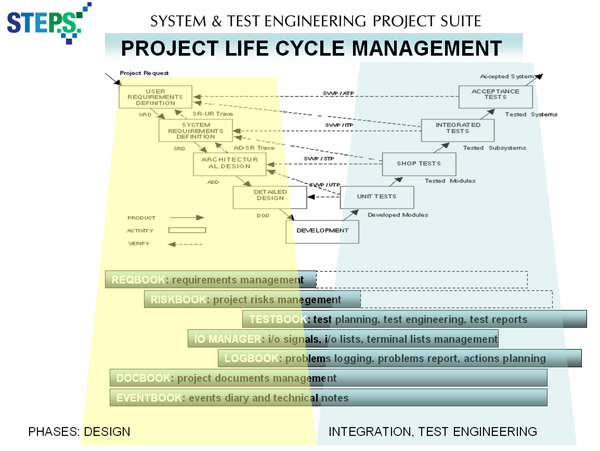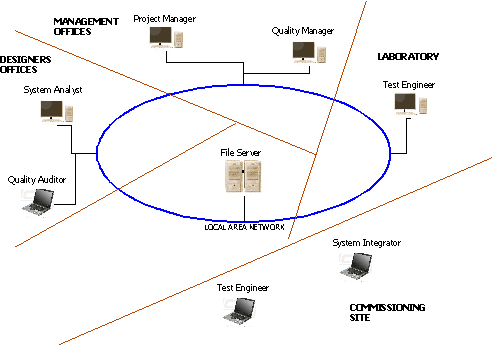|
|
 System & Test Engineering Project SuiteSTEPS IS A SOFTWARE PRODUCT BASED ON THE ORIGINAL PTESY CONCEPT System & Test Engineering Project SuiteSTEPS IS A SOFTWARE PRODUCT BASED ON THE ORIGINAL PTESY CONCEPT
ESSENTIAL HIGH-LEVERAGE METHODOLOGIES AND TOOLS FOR THE IMPROVEMENT OF THE PROJECT DESIGN PROCESSES |
![]()
THE NEEDED QUALITY STANDARDS (R)EVOLUTION
During the last quarter of the Twentieth Century the industrial world made very huge investments in quality, most of all in the production processes. The results of those investments are controversial, mainly due to the redundant complication and proliferation of standards, different in titles, but substantially similar as contents.
During the last ’90s and the first decade of the Twenty First Century, a real shift of paradigm occurred, and several new, progressive, concepts saw the light. And the focus moved to the design processes, nomore only on the production processes.
The concept of maturity (Capability Maturity Model, by SEI, Massachusetts) is more suitable, for a better approach to the project life cycle management.
Mechanical Quality vs. Electronic Quality– The methodology standards were born in industrial age, for mechanic industry, and are oriented to serial production processes. Electronics and computer science brought to a hugely greater freedom and flexibility.The critical focus moved to design processes.
Public Quality vs. Private Quality – Developed mainly in the public segment (Aerospace and Defence) methodologies are expensive and not efficient.
Standards as products for market– A real market of standards was born. Many similar standards were made, increasing confusion. This is conceptually opposite to the basic philosophy of the quality standards, which recommends that each requirement was unic, until when a differentiation is needed (due to technological or process reasons).
Cultural delay about the use of software tools to support methodologies indeed – methodologies are not sustainable, without suitable software tools.
Some recent standards aim in counter-current, with respect to the continuous standard proliferation:
– the focus moved from documents to processes
– a certain generalization is searched: horizontal methodologies, valid for any hightech technologies
– an approach to essential: opposite to code everything in minimum details
The capabilities considered primary, in this new scenario, includes:
– productivity and efficiency (duly measured and documented)
– safety, availability and maintainability of the developed systems
– to be able to make reliable financial/time estimations
– to be able to manage the changes in a quick and efficient way
Standards shall be restructured, rationalized and definitely decreased in number.
The software tools, to support essential and high-leverage methodologies, assume a big relevance for the above goals, to help the design teams to grow up in capability maturity.
OUR PROPOSAL
We propose a suite of software tools to manage the whole project life cycle, in a very effective and costs-reducing way. How? Hereafter a quick presentation of the main points.
![]()

The classical Project Life Cycle, though theoretically correct, is very seldom fully applied: in normal projects, the requirements and system design documentation become quickly too heavy to follow the project at the required speed. Needs to change the user requirements occur after each project milestone (design review, shop test in simulation, integrated tests, acceptance tests). The correct changes management required a review of documentation each time. But the delivery/invoicing milestones often constrain to delay the documentation upgrade. The result is that documentation often remain backward, wrt the developed project: it costed a lot, but is useless for the product maintenance.
Many corporates never really passed from waterfall to life cycle models
![]()
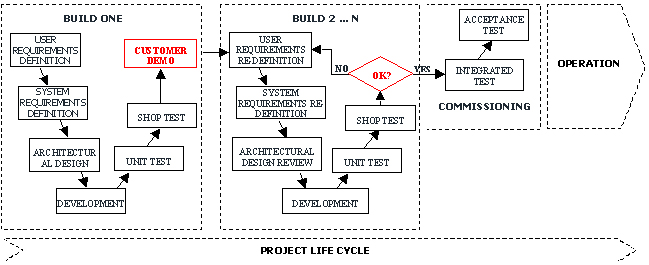
The Reiterative Project Life Cycle is not different, in principle, from the classic Project Life Cycle: the phases are the same, as well as the foreseen documents and activities. The only difference is that the RPLC explicitely foresees to cycle on the design-prototyping phases until customer full satisfaction.
![]()
The experience, and the most advanced standard methodologies (i.e. the Capability Maturity Model), showed that to work according to the above model is possible only using proper software tools.
Andromeda owns a remarkable design experience in the field of the process control systems, in the aerospace and infrastructural sectors, for human life support systems, where reliability and safety are primary requisite.
STEPS is a suite of tools to manage the whole project life cycle, in reiterative way, on relational database: from the requirements definition, to the definition of test procedures, to the test execution and problems annotation, up to the final acceptance test, tracing all the intermediate levels. The system implements a total online traceability matrice, and automatically (re)produce the whole documentation, already formatted in MSWord.
Thanks to the power of the 4th generation relational database, such a system allows to analyze and to manage the changes with extreme facility and rapidity, maintaining upgraded the project documentation and the traceability matrices, very efficiently and time saving, up to the end of the project.
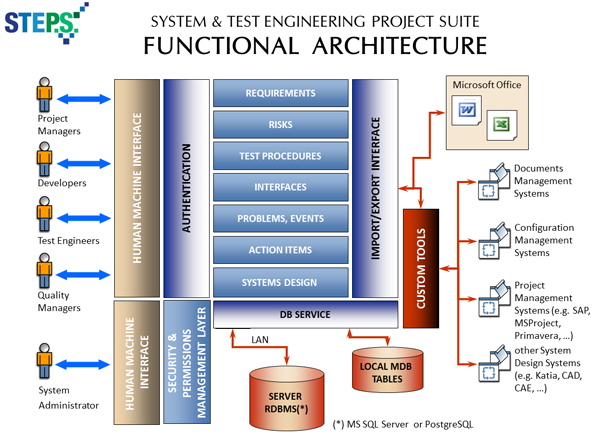
STEPS automatically produces the following documents, in Office format:
|
objects |
documents |
Office |
|
REQUIREMENTS |
Requirements Documents, Children vs. Parents Requirements Traceability Matrices; Orphans and Childless Requirements. |
MSWord, MSExcel |
|
RISKS DOCUMENT |
Risks associated to requirements. Each risk’s mitigation action, assessment before and after mitigation. |
MSWord, MSExcel |
|
TEST PROCEDURES |
Test Cases vs. covered Requirements Traceability |
MSWord |
|
PROBLEMS AND OPEN ISSUES |
Problems Report (in compact and extended shape); |
MSWord, MSExcel, MSProject |
|
TEST REPORTS |
Test reports of the executed test procedures, complete of: compiled test steps (Pass/ProbID), Problems Report, Test Summary |
MSWord |
|
EVENTS AND MINUTES OF MEETING |
Events Report (in compact and extended shape). |
MSWord, MSExcel |
|
DOCUMENTS |
Documentation Tree, Table of the Applicable Documents, Table of the Referred Documents. |
MSWord |
|
I/O SIGNALS |
I/O Lists and Terminal Lists |
MSWord, MSExcel |
|
PLANNING |
Activities and open issues |
MSProject |
|
|
|
|
THE STEPS CLIENT-SERVER ARCHITECTURE
|
|
![]()

![]()
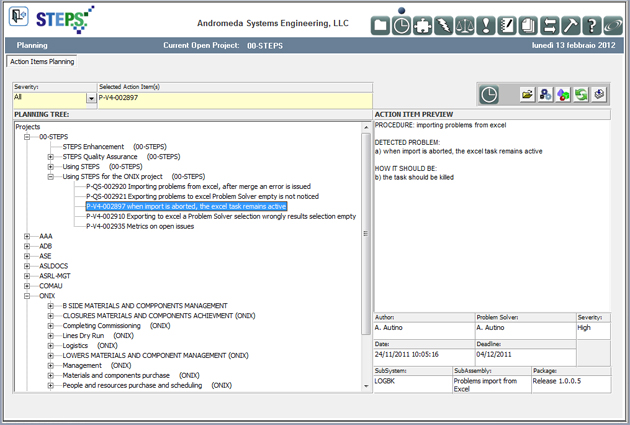
![]()
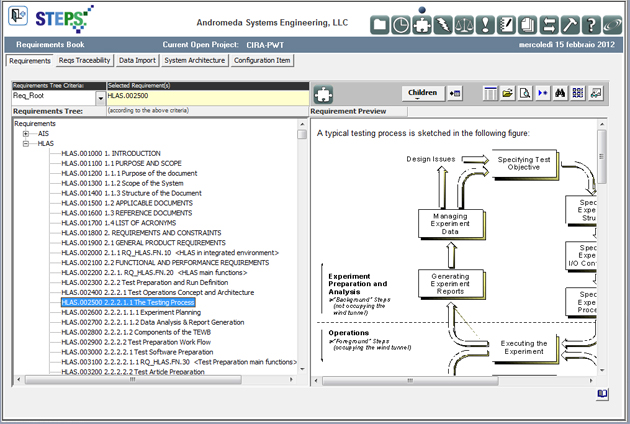
![]()
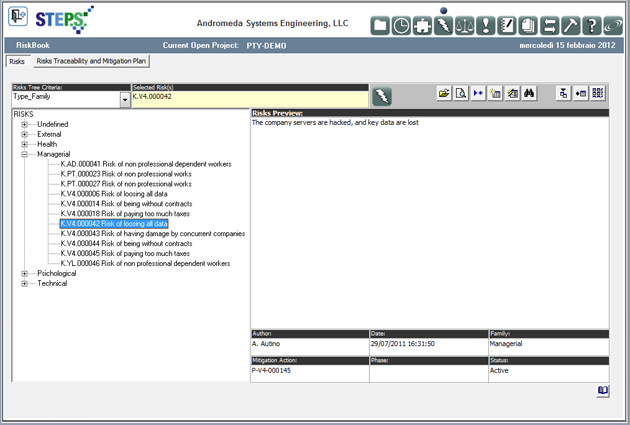
![]()
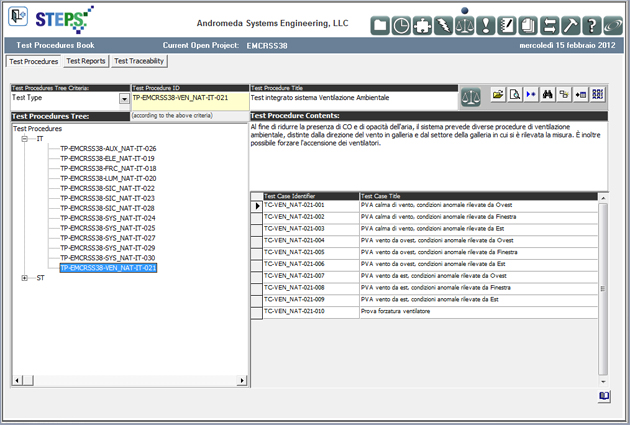
![]()
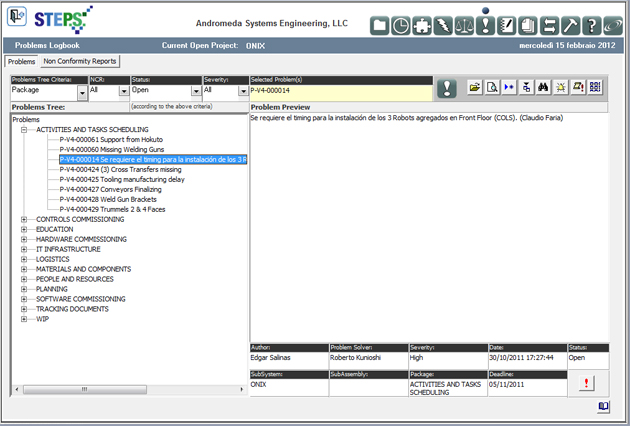
![]()
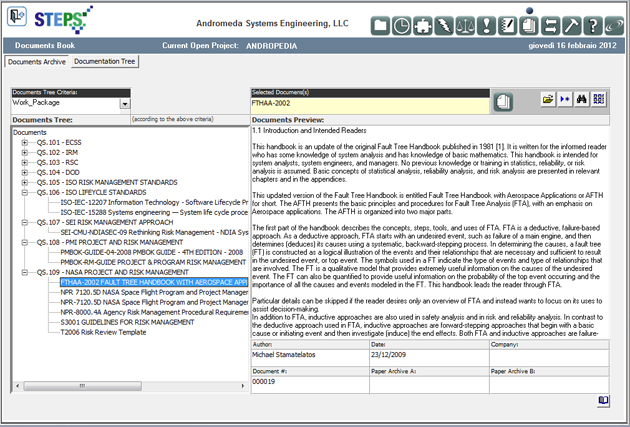
![]()
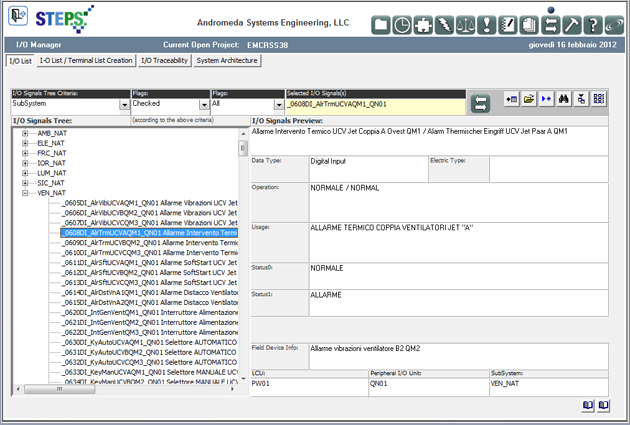
STEPS VS. OTHER COMMERCIAL TOOLS
|
ITEM |
STEPS |
COMPETITORS |
|
LIFE CYCLE COVERING COMPLETENESS |
STEPS covers the whole life cycle, in integrated way: requirements, architectural design, test procedures, problems annotation, i/o signals archive/history, documents management, data safety; all life cycle data are managed with the same relevance, and properly traced. |
Mainly focused on requirements management. Test cases are seen as properties of requirements. The life cycle is not specifically addressed. |
|
USABILITY, BY WHO |
STEPS is a full client-server system, it can be used not only in laboratory, but also in office, by the program managers, quality managers, |
Not client server systems, and can be used only in laboratory.
|
|
USABILITY, WHERE |
STEPS can be used on portable computers, on the commissioning site, making then a merge of the offline worked data on the server. |
|
|
EASY OF USE |
STEPS is very easy to be used. It is endowed by a powerful help system, composed by tutorial cards on all the meaningful forms and an |
Need a long training, are very complicated to use, only for very skilled personnel. |
|
PERFORMANCE |
STEPS produces automatically all the documents, in Office format: requirements documents, test procedures, test reports, traceability matrices, i/o lists and terminal lists, problems and issues, technical notes reports, and others. |
|
|
EDUCATION NEEDED |
Max one week, including a seminar/demo, installation and the preparation of a first project environment. |
|
|
EXPERIENCE / COVERAGE |
Our experience covers several application environments: Industry, Aerospace, Defence, |
Mainly focused on aerospace and defence. |
|
TECHNOLOGIES |
According to the user needs (namely the dimension of the project groups) STEPS can be Fully project oriented, STEPS creates a dedicated databae schema for each new project. |
Use proprietary heavy database engines. |
|
OPENNESS |
STEPS is fully open to the Microsoft world applications: MS Office, and the modern object oriented SCADA systems. STEPS can use any relational database, by the ODBC interfacing. |
|
|
COST |
STEPS is a low cost tool. |
|
|
QUALITY STANDARDS |
STEPS is fully compliant to the Project Life Cycle model. |
|
|
CAPABILITY MATURITY MODEL |
STEPS helps the project teams to grow up in maturity, from level 2 to level 3 of the CMM. |
|
|
STANDARDS: |
STEPS is compliant with the following international standards:
|
||||||||
| email: info@ase-ltd.co.uk | |||||||||
|
REQUEST US A TRIAL LICENSE: |
STEPS TRIAL 30 DAYS (English)
NOTE: STEPS was tested so far on Windows 7, interfacing Microsoft Office 2010 (Words and Excel) and Microsoft Project 2007 |



